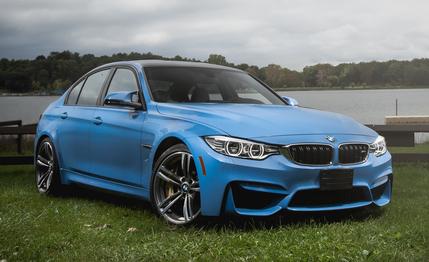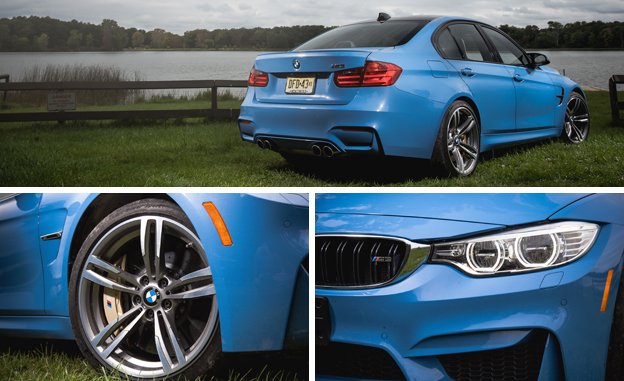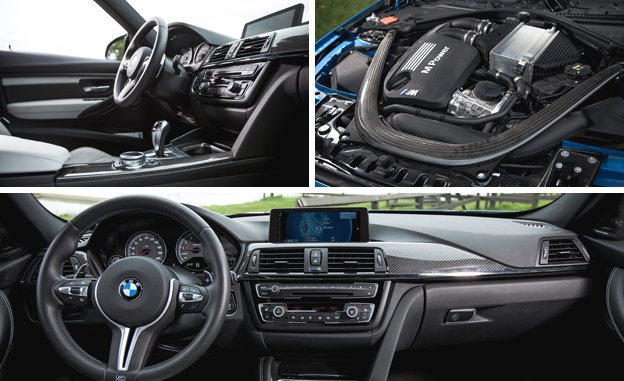 Instrumented Test
Instrumented Test
It’s probably fair to say that BMW sees the current F80 M3 as the fully weaponized version the company was destined to build, a car which, having evolved through its E30, E36, E46, and E90 generations, is now the ultimate synthesis of the brand’s engineering might and dynamic credentials. And if the criteria are that the car be capable of captivating through not only its handling and racy visuals, but also brain-liquefying performance, then there’s no doubt that this DCT-equipped M3 is the pinnacle of the breed.
The numbers are indeed astonishing. Sixty mph from a rest? Dispatched in 3.8 seconds. Zero to 100 mph? Consider it done in 8.5. The quarter-mile? Twelve flat at a scorching 119 mph. Stopping? It’s a master at that, too, decelerating from 70 mph in a tidy 153 feet. The M3 also grips a skidpad like Shel Silverstein’s Yipiyuk, holding on for 0.99 g. These numbers, it must be noted, are just one rung down from those of cars costing three to four times as much, and the 1.9-second 30-to-50-mph passing time actually ties the figure we recorded with the Lamborghini Huracán. Midrange grunt: The M3 has it.
However, we report those figures with something slightly less than glee. It’s not that the car isn’t breathtaking to experience, because it is. It’s not that it doesn’t still feel special, because it does. It’s that the M3 posts its numbers with less involvement and joy than it once did.

Yes, the M3 has fully embraced its digital side, as exemplified by its having up to nine chassis settings—three each for the powertrain, suspension, and steering—plus, in this automatic-equipped model, another six modes for the transmission. (There are also various stability-control programs.) This is all probably necessary to deliver the scintillating numbers, if there can be such a thing, but dialing in the car for your particular taste has never been so easy or so perplexing, which forces us to ask: Whatever happened to BMW being the tastemaker, delivering one perfect chassis tune and allowing you to discover its nuances?
Yet despite this whining, the M3 remains one of the best cars available today. Brake feel is superb, with a quick, short pedal stroke facilitating easy, race-car-like modulation and world-class deceleration. (Our car had the $8150 carbon-ceramic mega anchors.) The response of the S55 inline-six to accelerator inputs is stupendous, especially when you consider that it has to spool up two turbos to deliver its chest punch. The skidpad figure translates to grip that’s easily exploited in real-world conditions, and a rear subframe bolted directly to the structure—no bushings here, man—provides ample feedback about the rear-end’s behavior at the limit. This is good, because as we’ve noted before, very little information makes its way to the driver via the steering wheel. The steering otherwise is quick, linear, and responsive . . . but it’s numb. For this reason, we preferred the steering’s Comfort mode even during strafing runs, as going more aggressive doesn’t seem to benefit turn-in, and stepping up in weight just makes changing direction more of a chore for the driver.

As to the gearbox modes, there are three each for automatic and manual operation, and they dictate how quickly and firmly the ratios are swapped. In the most aggressive steps, they’re rightgoddamnnow quick and slap-upside-the-head firm; the softer settings are still crisp but more livable for everyday use. We would gladly, however, give up all of that in favor of the six-speed manual transmission—and we did, in a way, opting for that gearbox in our long-term M3. That version is slower and less techno-awesome, but it’s also more involving, as you cede less control to silicon wafers buried deep within the dash.
Our M3 DCT test car rolled through our office with its $65,850 base price ballooned by nearly $20,000 in options. The beautiful blue paint—the same Yas Marina hue as on our long-term car—cost $550, “enhanced” Bluetooth and phone integration ran $500, and Harman/Kardon surround sound added $875. There were the pricey brakes, as well as $1200 19-inch wheels, the $1000 Adaptive M suspension (which really ought to be standard), the $2900 transmission, and two packages: Lighting (adaptive full-LED headlamps and auto high beams, $1900) and Executive (heated steering wheel, proximity entry, rearview camera, headlamp washers, parking sensors, a head-up display, and satellite radio, $4300). In fact, save for the gearbox, this car is equipped identically to our long-termer.
The total of $84,325 is eye-watering, but you can live without a bunch of that stuff, and the M3’s ridiculous speed and overall dynamic goodness can make it still feel worth its price. Larger and more complicated than ever, the automatic-equipped M3 is perhaps the best demonstrator of the Bavarians’ mighty engineering talent and drive for perfection—we just hope there’s a little more of the old M3 magic on the next spec sheet.